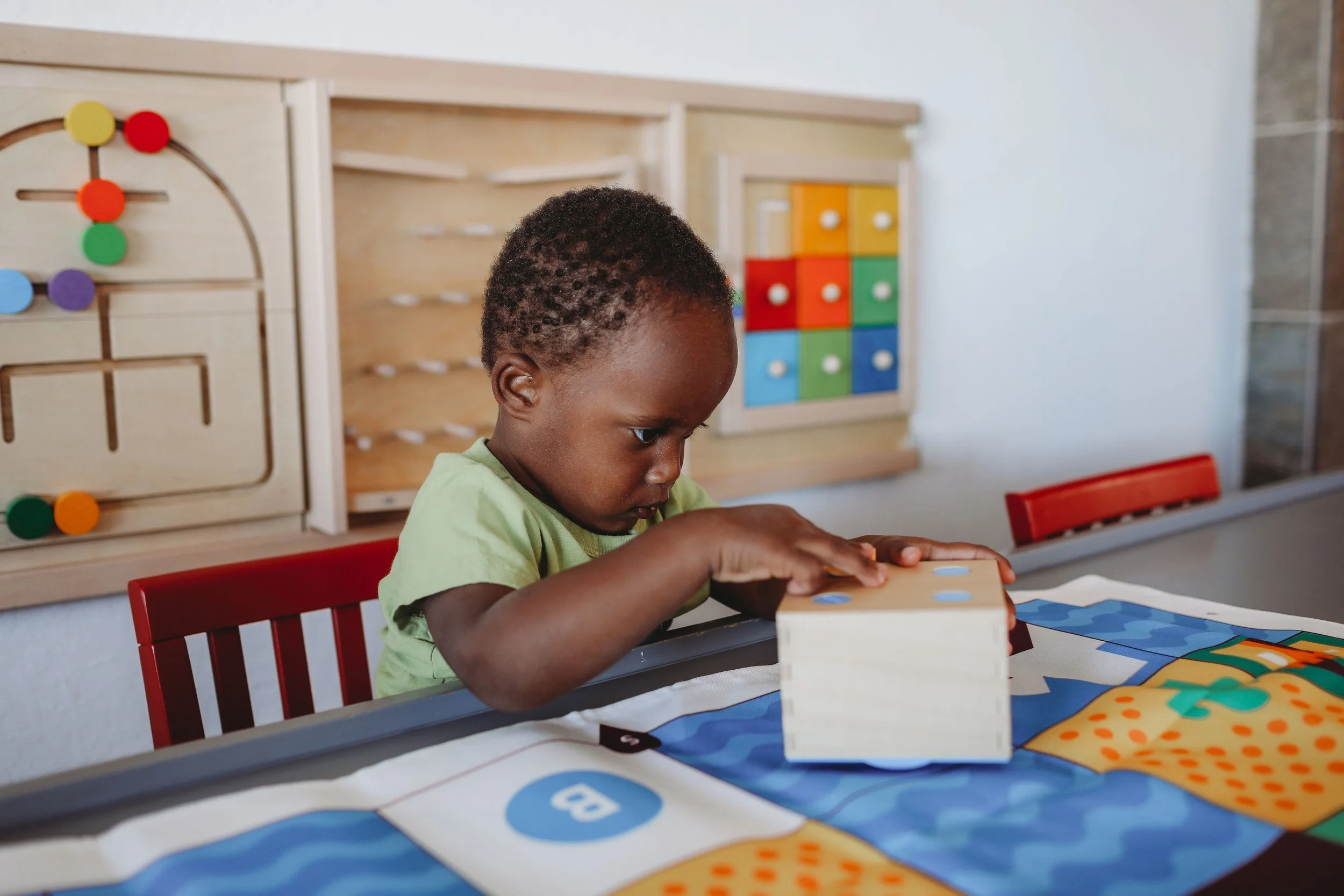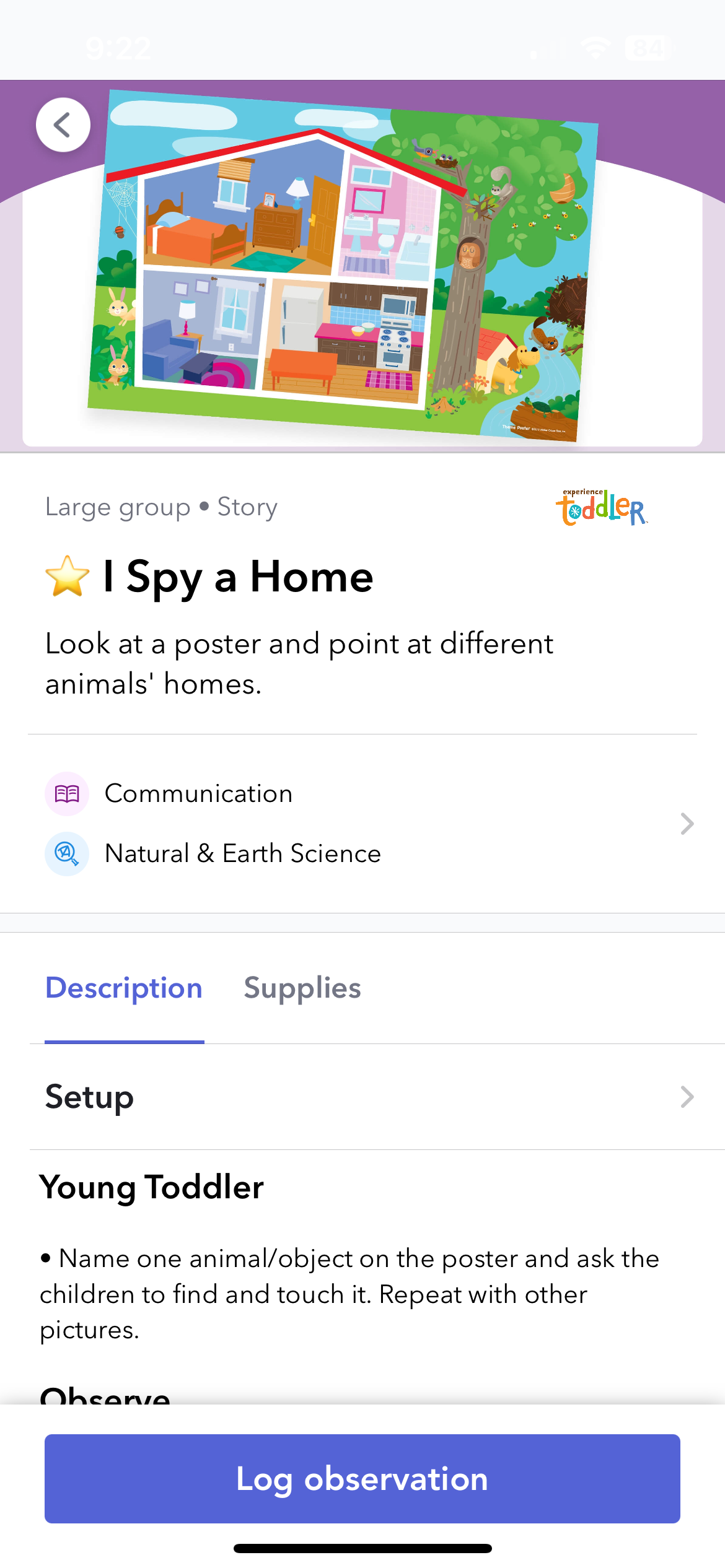Experience Toddler Overview
At the core of all learning is a trusting and loving relationship.
Experience Toddler Curriculum is designed to help teachers support each child's natural growth and development through responsive care and sensory learning experiences. It is designed to nurture each child's unique potential and connect with their expanding curiosity about our diverse and beautiful world.
- The Experience Early Learning Team
HIGHLIGHT
Toddlers learn best through play and sensory discovery. Each week, children experience at least 15 weekly activities across four learning domains - Language & Literacy, Art & Drama, Math & Reasoning, and Music & Movement. Since children develop at their own pace, teachers can increase the challenge of each activity to match the developmental level of each child. In addition, each activity intentionally embeds 1-2 skills. As children play, teachers use question prompts to guide their observations.
WEEKLY FEATURED BOOK
Each month features four types of books (Follow the Path, Forest Friends, Nursery Rhyme, Storybook) that support key social-emotional and emergent literacy skills. Weekly activities are planned around the featured book.
Follow the Path expands vocabulary with photos. Children explore early reading and writing skills by tracing over the path from left to right on each page. Follow the Path reinforces direction of text and eye-hand coordination.
Forest Friends nurtures social skills through stories of friendship and values.
Nursery Rhyme strengthens listening and communication skills by finding new pictures and words.
Storybook expands imagination be getting to know story characters, acting out their obstacles and how they solve problems.
WEEKLY EXPERIENCES
Across the four learning domains - Language & Literacy, Art & Drama, Math & Reasoning, and Music & Movement - there are multiple ways children explore:
Language & Literacy - Book Discovery, Story Play, Communication, Pictures & Letters and Active Listening
Art & Drama - Sticker Art, Dramatic Play, Painting, Collaging and Coloring
Math & Reasoning - Sorting & Shapes, Measure with Me, Sensory Play, Life Skills and Number Play
Music & Movement - Group Dance, Coordination, Creative Movement, Rhythm Pattern and Sounds & Signs
Experience Baby Overview
Experience Baby Curriculum supports relationship-based play and discovery. It is designed to nurture warm and caring emotional connections with children that build trust and security. It is designed to offer play opportunities that invite children to engage, explore, and discover their environment through everyday routines.
- The Experience Early Learning Team
HIGHLIGHT
Experience Baby's responsive curriculum naturally supports children's emotional, physical, language and cognitive development. Each week, children experience at least 10 weekly shared experiences across three learning categories -
Connect & Communicate (Social Emotional and Language),
Move & Grow (Physical Development), and
Play & Explore (Math & Reasoning)
Since children develop at their own pace, teachers can simplify or increase the challenge in the way they play with the child to best match the developmental level of each child. As such, there are three levels of interaction for each shared experience (i.e., young infant, older infant, young toddler). In addition, each activity intentionally embeds 1-2 skills. As children play, teachers use the reflection question prompt to investigate the cues that the child offers about their interests, challenges and strengths. These questions help deepen their understanding about the who the child is.
TYPES OF PLAY
Experience Baby engages children in nine types of play:
Looking
Pushing and Pulling
Stacking and Nesting
Rolling
Filling and Spilling
Grabbing and Squeezing
Covering
Imitating
Shaking and Pounding
READ WITH ME - 5 WAYS!
Experience Baby encourages daily reading. Each month, Experience Baby supports five ways to read with babies. These five approaches create a unique experience with each book.
Read with Expression: Read with expression and use different voices for different characters.
Point to Pictures: Point to pictures to build vocabulary. Look for similar objects or pictures throughout the day.
Play with Sounds: Play with sounds and find at least one word, sound or sound effect on each page to repeat multiple times. Encourage the child to repeat the sounds or words while you read.
Child Holds It: Keep books in a basket or on low shelves so the child can independently choose their own book and explore it.
Include a Prop: Include a prop for the child to hold and interact with while reading the story.
As an example, here are five ways a teacher might read The Three Little Pigs:
Read with Expression: Read with a loud voice when talking about the wolf and with a high voice when talking about the pigs.
Point to Pictures: Point at the pictures in the book. For example, ask the child, "Where is the pig? Where is the house?"
Play with Sounds: Explore making different huff and puff sounds. Experiment with squealing sounds. Observe which sounds the child repeats.
Child Holds It: Encourage the child to hold the book and turn the pages. Say what you see while the child turns the pages.
Include a Prop: Give the child some blocks or a stick to hold while you read.
Preview Daily Activities in Brightwheel
We are happy to open our lesson planning books and share a preview of the activities children will be learning each day. In Brightwheel, under Learning, simply click on the date and you'll discover an overview of the daily activities and centers (if applicable). You'll find a description of the activity for infants, young and older toddlers along with the skills embedded in the activity.
Observing & Documenting Growth
Each day, teachers document their observations for one activity. For 1-2 embedded skills (e.g., Measurement), teachers document each child's demonstrated skill level along with a photo/video and a note briefly summarizing the activity. You'll find this observation in your child's daily feed.




